One thing that will start a war in motorcycle forums or FB groups is to ask oil questions. What is the best oil for my motorcycle? What motorcycle oil brand is this motorcycle, or worse, asking if synthetic or conventional motorcycle oil is best?
Another sore subject is how often do you need to change your motorcycle oil. Let’s talk about how often a motorcycle oil change is necessary.
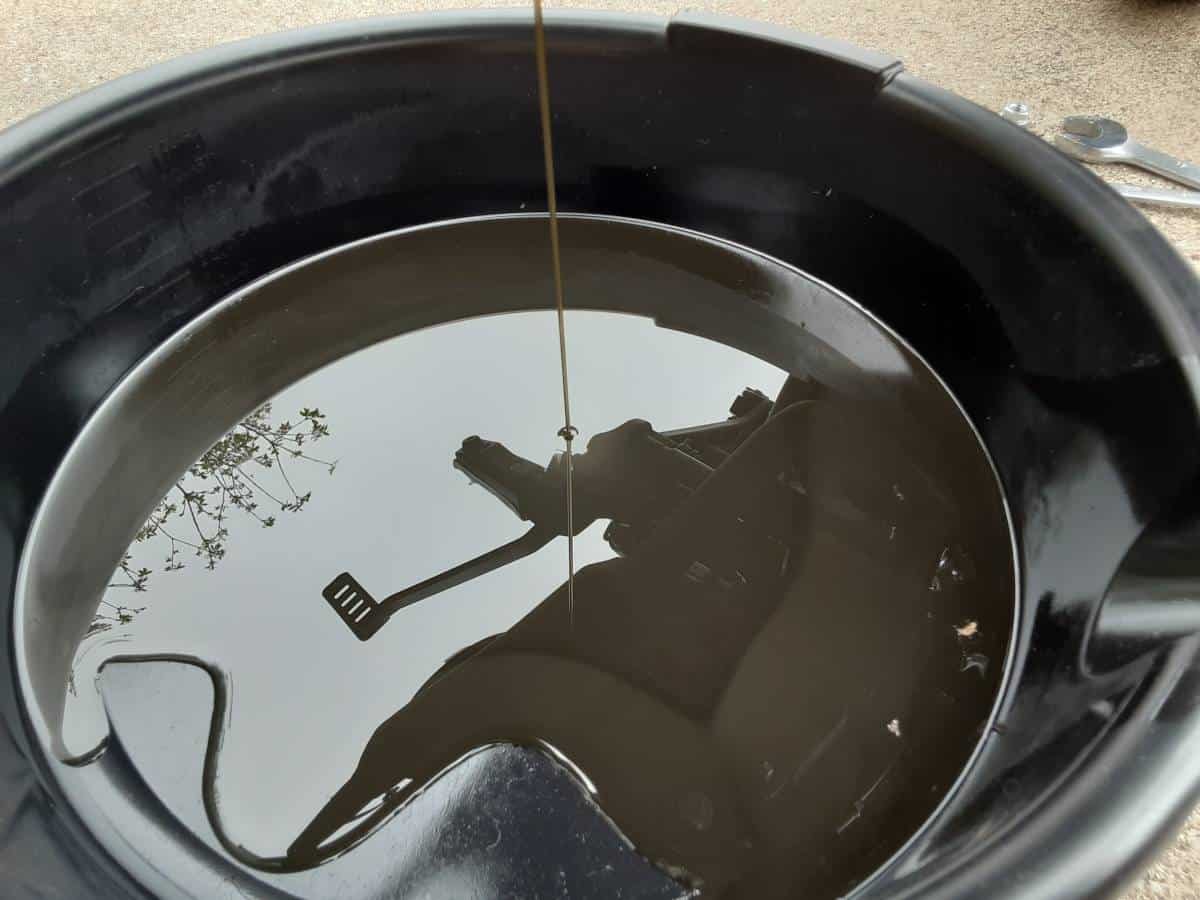
Why The Differences In Motorcycle Oil Opinions?
Well, my goal is to cover the topic of motorcycle oil change intervals. Still, I feel my oil observations over time may apply to all motorcycle oil conflicts.
There are so many types of motorcycle oils, so many types of motorcycles, so many brands, and worse, so many types of riders. All these motorcycle riders use and treat their motorcycles differently.
How Often Are Motorcycle Oil Changes Needed?
Simple answer????
When the motorcycle manufacturer says so!
Look in your Motorcycle Owners Manual, and there should be an oil change interval. Usually in miles(Kilometers). Use this if you want to keep your oil change interval simple.
Read on if you want to find out other factors that might have you changing your motorcycle oil sooner(more frequently).
Follow The Manufacturer’s Oil Change Schedule?
I say YES! But, as a maximum interval.
If the bike maker says to do an oil change every 3,000 miles, it means to me, never exceed 3,000 miles between engine oil changes.
However, if any signs or riding habits make you question the service life of your oil, you should do an oil change.
I ride my TaoTao TBR7 motorcycle mainly on the streets, which, of course, have road grim and dirt that can get into the engine and, ultimately, the engine oil.
Also, just riding the motorcycle, carbon and soot can accumulate in the engine oil over time.
However, I do question how well I treat the motorcycle.
I ride my motorcycles(Boom Vader Gen 2 and TaoTao TBR7) like they are stolen. These small engines are run at high RPMs constantly to make up for the theme of being small-displacement single-cylinder engines.
I only get real power running these engines very high in their RPM range.
This hard riding burns more fuel(so more exhaust products like carbon and soot) and higher temperatures(so I want my oil as ‘fresh’ as possible for proper viscosity). Therefore, I do more frequent oil changes, not always by measurable factors like miles and time.
I look for signs that my motorcycle oil needs a change.
Signs Your Motorcycle Needs An Oil Change:
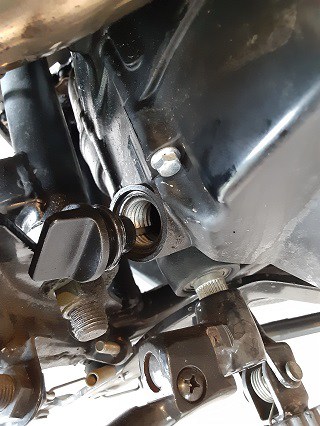
1.- Drop In Oil Level To Minimum Level.
Now how do you know if your motorcycle oil is low?
Well, of course, we always check our engine oil level before we start riding our motorcycles (ROLLING EYES). Also, when we do, we note the changes in oil levels over time. So this should be no surprise to us. 😀
Some oil is consumed with regular engine use. As a result, the oil level in the motorcycle engine’s sump will decrease. Once you get to the minimum level, it’s a good indication your motorcycle engine oil at the end of its life, and it’s time to change the oil.
Note: if you have an oil leak, this can lead to premature declines in your oil level. Get those oil leaks fixed. My Oil Leak: Oil In Airbox Motorcycle Solutions.
Warning: Can You Add Motorcycle Oil Instead Of Changing It?
I found this is not ideal, and it just kicks the can down the alley. If you have to ride your bike and there is no time to do an oil change, adding some fresh motorcycle oil will add clean oil and additives.
This is a temporary solution, akin to not having time to wash the dirty clothes you are wearing but putting on clean socks instead. Do the oil change, and don’t become lazy. Remarkable analogy, right?
2.- Loud Or Unusual Engine Noises.
As discussed before, fresh oil flows and is at the viscosity designed by the manufacturers. This changes with use and time; oil thickens and thins and behaves differently as containments build up.
Notice how your motorcycle engine sounds after an oil change. I feel my motorcycles are happiest right after an oil change.
Now with time, as oil doesn’t flow well or doesn’t create that oil wedge between moving engine parts, the motorcycle’s engine starts making additional or weird sounds. Like it’s not running at peak performance.
If this is the case, an oil change might be needed—time to change that motorcycle oil.
3.- Weird Smells, Burnt Oil
I had a couple of overheating incidents in the past( Overheated Motorcycle Engine Problem(s) ). I’ve taken steps to prevent this( Exhaust Wrap For Motorcycles, My Experiences ) and keep an eye out for any overheating symptoms( Air-Cooled Engine Overheating Symptoms? ).
However, one thing I learned, one of the symptoms of an overheating engine is the oil smell. It smells like the burning oil from a fast food joint. And continues to smell “off” long after the event.
If your engine smells ‘weird’ or when you check the oil, the oil smells ‘burnt,’ time to change the motorcycle oil.
4.- The Motorcycle Engine Oil Looks Black and Gritty.
When you check your motorcycle oil, look at the condition.
I use white paper towels to clean off the oil dipstick and check the oil level. I then look at the paper towel. Does the oil look ‘dirty’? Is there ‘texture’ like grit in the oil? If so, time to change the oil.
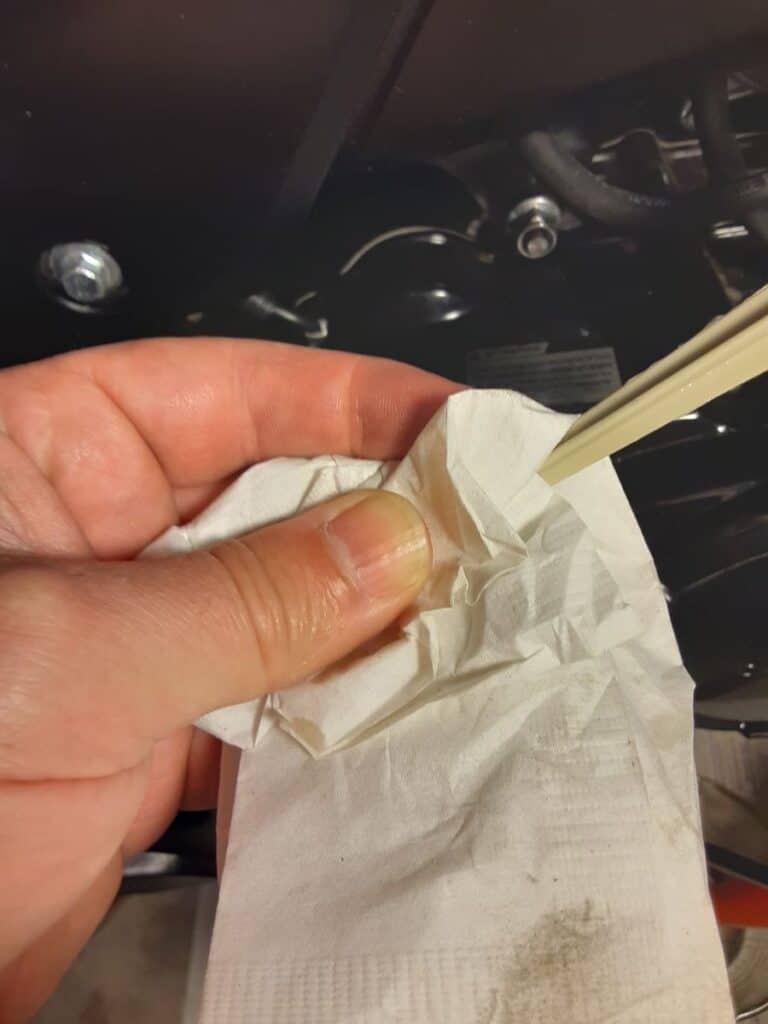
5.- Change In Shifting Gears, Ease And Feel.
Motorcycles usually have wet clutches, mine do, and engine oil designed for wet clutch motorcycles is necessary. It’s a type of engine oil that works with the clutch friction plates to keep them cool and balance out their friction qualities, giving you a smooth shifting clutch.
If your engine oil is ‘old,’ the lubrication properties might be in the design range for your motorcycle’s clutch. This change in oil properties can result in difficulty shifting, faster overheating when using the friction zone, or even accelerated wear in the motorcycle clutch plates.
Considering motorcycle clutch replacement costs, not only is good motorcycle oil lead to a good ride, but longer life clutch plates. So change your oil as you feel a change in your gear shifting quality.
6.- Can’t Remember The Last Motorcycle Oil Change.
Yup, been here. I didn’t write down the mileage or the date of the last motorcycle oil change and figured, If I can’t remember, it was too long ago.
So if the last oil change in your motorcycle was so long ago that you forgot when you did it, it’s time for an oil change.
Motorcycle oil isn’t too expensive and way cheaper than repairing any engine failure.
I typically keep notes, writing down information on a post-it and sticking it to my garage wall. Still, in the past, even doing the right thing, I lost those notes—blown away when the garage door was opened. If the motorcycle oil didn’t like new, or I knew when I did the last oil change, I just changed the oil.
I buy decent motorcycle oil( What TBR7 Oil Type Do I Need? & Boom Vader Oil Type – FAQ ) by the gallon, so it’s cheap insurance against engine failure.
Why We Don’t Listen To The Manufacturers Oil Change Intervals.
I genuinely believe there is a mistrust of motorcycle manufacturers, and the manufacturers seem to perpetuate this.
Look at the motorcycle weight often listed in online advertisements. You can’t take that information at face value. You have to ask, wet? Dry? Curbside? Etc.
How about motorcycle horsepower? Is the advertised horsepower rating measured at the engine crank or the wheel?
Now we have a root cause for our mistrust. Let’s move on or correct it.
Things We Know About Motorcycle Oil Changes.
We accept frequent oil changes to prevent motorcycle engine damage and excessive wear. Still, TOO frequent oil changes increase the cost of ownership and are wasteful of oil resources.
OK, basic, but understood, and most of us can agree to this.
Let’s Cover Why “Fresh” Engine Oil Is Important.
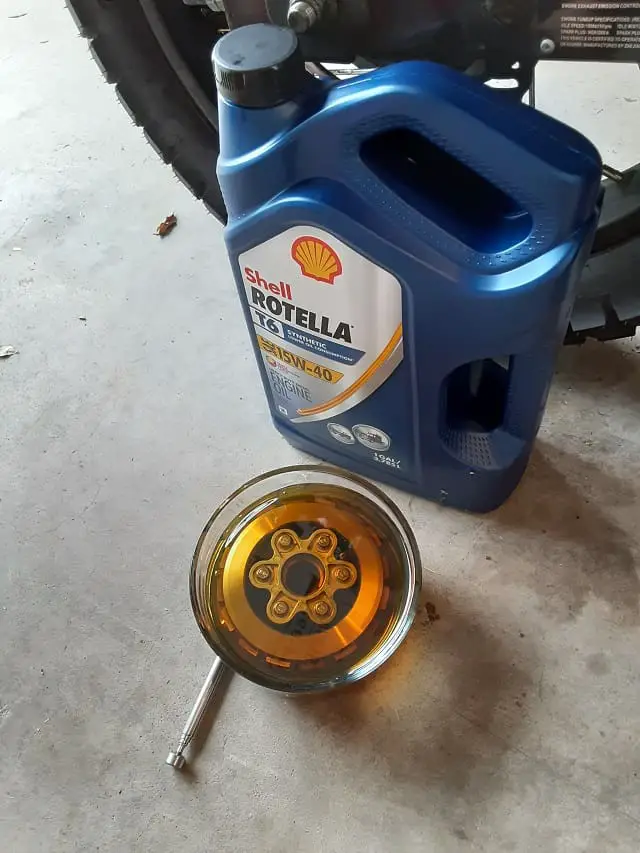
1.- New Motorcycle Engine Oil Is Well, It’s New.
This means the motorcycle oil is operating as it should, leaving the factory. Meaning the oil does what is listed on the oil bottle.
FYI: Viscosity measures a fluid’s ability to flow (https://en.wikipedia.org/wiki/Viscosity).
After the oil starts getting used, the oil’s viscosity can change.
Little moisture in the oil, and the oil becomes thinner. With little dirt and soot in the oil, the oil becomes thicker and more viscous.
Oil too thin doesn’t allow for enough oil to stay between moving engine parts and allows for direct metal-to-metal contact. This metal-to-metal contact of moving parts can increase friction, cause overheating and damage the metal.
Oil too thick doesn’t flow well into tight spaces—starving areas of oil and resulting in metal-to-metal contact of engine parts.
Changes in oil flow can also change the ability to cool internal motorcycle engine components since the oil absorbs heat from friction and carries it away. A principal I used to help keep my TaoTao TBR7 motorcycle engine cooler by installing an oil cooler( Oil Cooler Installation For My TaoTao TBR7 Motorcycle ).
2.- Fresh Motor Oil Has The Highest Additives Of Its Life.
You might wonder what these additives are or why they are essential since motorcycle oil is used, for one thing, to lubricate engine parts.
Well, these oil additives allow oil to lubricate under adverse conditions.
Ever noticed moisture coming out of the exhaust or the seams of your exhaust system when you first start up your motorcycle?
That moisture is condensation from water vapor created from burning gasoline and condensing on cooler parts, like the not warmed-up parts of your motorcycle engine and exhaust system.
Well, this water can get into the oil, losing its viscosity protection and leading to direct metal-to-metal contact. So oil manufacturers use anti-emulsification agents to keep moisture droplets from accumulating and dominating the motor oil.
Also, the same water can mix with exhaust products and form an acid that will erode way layers of metal over time.
So again, oil manufacturers put in pH buffers to keep oil pH in a safe range when acids are created.
Once the motorcycle engine warms up, that collected water will slowly evaporate. Still, in the meantime, without the oil additives, the engine damage done is irreversible.
3.- Fresh Oil Has No Contaminants.
As mentioned before, moisture can get into the oil and cause acid attacks on metals. Still, additives minimize this till the water evaporates.
Well, one thing that gets into the oil but doesn’t ‘evaporate’ is dirt and grim. Many motorcycle makers now include oil filters with their bikes, but there is a secret: those filters can’t work too well.
If they were 100% filtration, the oil filter life would be very short due to clogging too soon. And if they clog while riding, you could start starving your motorcycle engine of oil flow.
Understand an oil filter that works too well; often, engines or the oil filter have a bypass to allow continued oil flow when the oil filter is clogged.
What does this mean? Well, oil from day one in your motorcycle engine will start accumulating dirt and grim. This dirt and grim will work as abrasives leading to additional wear on your engine’s moving parts.
Again, fresh oil comes out of the bottle with no abrasive materials.
We now understand why fresh motorcycle engine oil is good for the bike. How about what happens when we don’t change engine oil frequently enough?
What Happens When You Wait Too Long For An Oil Change?
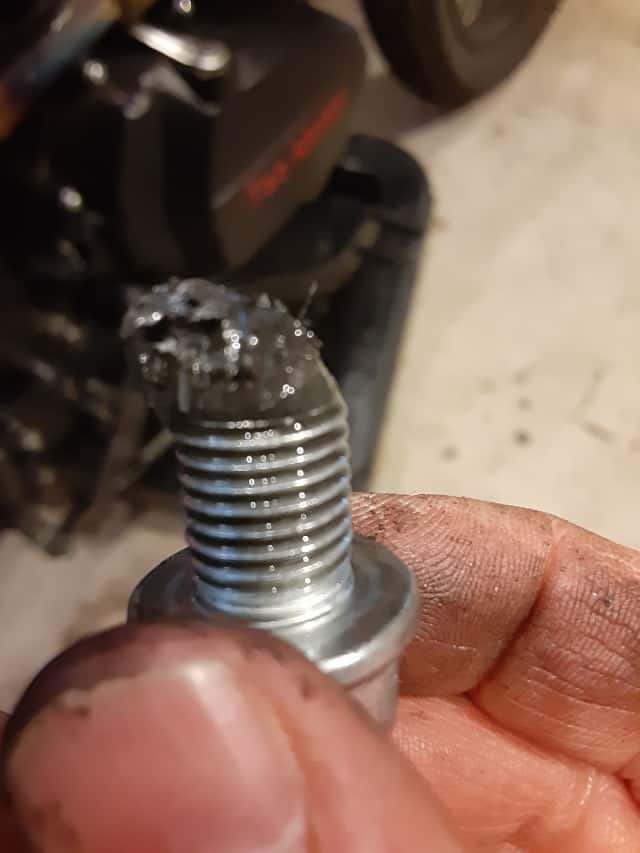
Like many parts of your motorcycle, motorcycle engine oil ‘wears’ out.
The pH buffers get used up, and then accumulated moisture can create acids that lower the oil’s pH and lead to erosion of metal parts.
The designed viscosity of the motorcycle oil will change over time. The oil becomes more viscous and abrasive with dirt, grim, and carbon build-up.
What Are The Effects Of Not Getting An Oil Change?
With more acid oil(low pH), metal surfaces can be broken down and eroded faster. They were leading to premature engine failure.
Thicker oil, ‘sludge,’ will slow down how fast it flows into tight engine spaces. These low-flow conditions can lead to more metal-to-metal contact and localized overheating of moving engine parts.
Road grime and grit can get into motorcycle oil; with an accumulation of these containments, they can act as abrasive compounds and wear out the engine’s materials faster.
These actions will damage the engines’ moving parts longer you ride under these conditions.
Anything Else Wrong With Not Getting Regular Oil Changes?
I believe I killed this topic of not getting regular oil changes, but I have to put the nail in the coffin for people who bought new bikes.
You can void your warranty.
Say you are not good at remembering oil changes for your motorcycle, and something goes wrong with the engine or maybe another part of your bike.
I heard some warranties could be voided based on how well you’ve been keeping up with regular maintenance. Oil changes are one of those maintenance items.
Not taking care of your motorcycle can be why warranty providers say they don’t want to take care of your motorcycle should something go wrong.
Having something fail on your motorcycle and having to foot the whole bill because of infrequently oil changes should scare some of you. I do me, and I buy cheap motorcycles( Why Buy A Cheap Chinese Dual-Sport Motorcycles? ).
Summary Of How Often Do You Need to Change Your Motorcycle’s Oil?
- When the bike’s manufacturer advises,
- When you are unsure about the engine oil’s condition,
- After an event that might damage the oil(overheating),
- Or when indications the oil might be at the end of life(oil level, or can’t remember last oil change).
Good engine oil is a vital part of the reliable continued operation of your motorcycle.
My motorcycles weren’t expensive, but both of them bring me joy when I get time to go riding. Having them ready to start up and go for a ride is essential to me.
When you get the itch to ride, I’m sure you want to spend more time with your knees in the breeze than pushing your broken-down motorcycle down the road to the nearest service station.
A New Motorcycle Rider Here.
I am a new motorcycle rider, owner, and tinkerer. The oil arguments might be nothing for people who just have settled on doing motorcycle oil changes per their Motorcycle Owners Manual. However, for new riders like me, I noticed the arguments and disagreements going back and forth between some motorcycle owners, and they seem to dominate the oil discussion. Oil discussions turn into Oil Wars.
I just wanted to share my observations and my understanding of information about the topic of motorcycle oil. If you have anything to contribute to this discussion, please leave a comment below. I value a good conversation.
How Often Do I Change The Oil In My TBR7 Motorcycle?
I’m sure some ask, do I practice what I preach here? Well, my TaoTao TBR7 dual-sport motorcycle is put through the wringer with how I ride it. I have done several upgrades to the bike, and I ride it hard and longer under higher speed conditions. Even highway conditions.
So I tend to have all the indications of overheating the motorcycle, and I have taken steps to avoid this with an oil cooler upgrade. I also use synthetic motorcycle oil in my bike to prevent viscosity breakdowns.
Even with these steps, I consider changing my motorcycle oil every 1000 miles. I don’t panic if I go over 1000 miles; I just put it on my to-do list for regular motorcycle maintenance.
Changing the TBR7 oil is relatively easy, and the TBR7’s oil capacity is low (1 quart, basically). There isn’t much upfront cost when I buy my motorcycle oil in gallon jugs.
Suppose you have a different schedule for your TaoTao TBR7 motorcycle, another Chonda bike, or any bike. Feel free to leave a comment below.
Ride Safe, Ride Fun!
FYI: Building My List of Must-Have Tools For Motorcycle Owners

Hi I’m Tom, A New Motorcycle Rider and Blog Author.
I am a new rider(Pa Learners Permit at the end of 2020, and I received a Pa Motorcycle License in 2021 after passing a Motorcycle Safety Course).
I bought my first motorcycle, a TaoTao TBR7, at the beginning of 2021 and have been doing upgrades on that motorcycle since.
I added to my motorcycle collection by buying a Boom Vader Gen 2 in 2022, and that Grom-Clone motorcycle has been upgraded by me as well.
I continue to ride my Boom Vader Gen 2 motorcycle as well as my TaoTao TBR7 dual-sport bike.
Read more on my About Me page.
Fun Fact: I’ve only been on one group ride.

